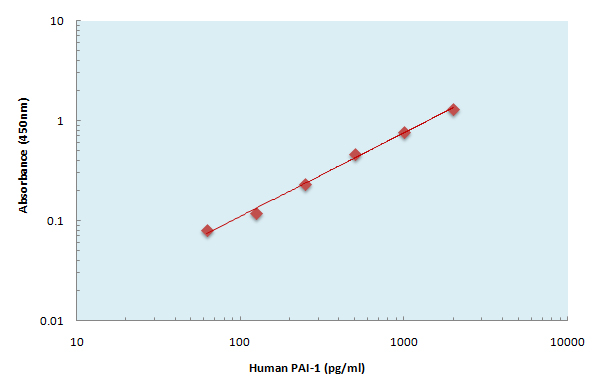Human PDGF-BB ELISA Kit
- Catalog No.:KE1056
- Applications:ELISA
- Reactivity:Human
- Gene Name:
- PDGFB
- Protein Name:
- Platelet-derived growth factor subunit B
- Human Gene Id:
- 5155
- Human Swiss Prot No:
- P01127
- Mouse Swiss Prot No:
- P31240
- Specificity:
- Sample Type for Cell Culture Supernates, Cell lysates, Tissue Lysates, Serum, EDTA Plasma, Heparin Plasma
- Storage Stability:
- 2-8°C/6 months
- Other Name:
- PDGFB;PDGF2;SIS;Platelet-derived growth factor subunit B;PDGF subunit B;PDGF-2;Platelet-derived growth factor B chain;Platelet-derived growth factor beta polypeptide;Proto-oncogene c-Sis;Becaplermin
- Detection Method:
- Colorimetric
- Background:
- disease:A chromosomal aberration involving PDGFB is a cause of dermatofibrosarcoma protuberans (DFSP) [MIM:607907]. Translocation t(17;22)(q22;q13) with COLA1. DFSP is an uncommon, locally aggressive, but rarely metastasizing tumor of the deep dermis and subcutaneous tissue. It typically occurs during early or middle adult life and is most frequently located on the trunk and proximal extremities.,function:Platelet-derived growth factor is a potent mitogen for cells of mesenchymal origin. Binding of this growth factor to its affinity receptor elicits a variety of cellular responses. It is released by platelets upon wounding and plays an important role in stimulating adjacent cells to grow and thereby heals the wound.,miscellaneous:A-A and B-B, as well as A-B, dimers can bind to the PDGF receptor.,online information:Clinical information on Regranex,pharmaceutical:Available under the name Regranex (Ortho-McNeil). Used to promote healing in diabetic neuropathic foot ulcers.,similarity:Belongs to the PDGF/VEGF growth factor family.,subunit:Antiparallel disulfide-linked dimer of non-identical (A and B) chains. Homodimers of A and B chains are implicated in transformation processes. Interacts with XLKD1.,tissue specificity:Expressed at high levels in the heart, brain (sustantia nigra), placenta and fetal kidney. Expressed at moderate levels in the brain (hippocampus), skeletal muscle, kidney and lung.,
- Function:
- response to hypoxia, regulation of protein amino acid phosphorylation, regulation of endothelial cell proliferation,positive regulation of endothelial cell proliferation, monocyte chemotaxis, DNA metabolic process, DNA replication,regulation of DNA replication, cell motion, substrate-bound cell migration, chemotaxis, cytoskeleton organization, cell surface receptor linked signal transduction, enzyme linked receptor protein signaling pathway, transmembrane receptor protein tyrosine kinase signaling pathway, transmembrane receptor protein serine/threonine kinase signaling pathway, transforming growth factor beta receptor signaling pathway, behavior, locomotory behavior, cell proliferation, positive regulation of cell proliferation, regulation of cell size, response to wounding, response to endogenous stimulus, response to hormone stimulus, negative regulation of biosynthetic process, posit
- Subcellular Location:
- Secreted. Released by platelets upon wounding.
- Expression:
- Expressed at high levels in the heart, brain (sustantia nigra), placenta and fetal kidney. Expressed at moderate levels in the brain (hippocampus), skeletal muscle, kidney and lung.
- June 19-2018
- WESTERN IMMUNOBLOTTING PROTOCOL
- June 19-2018
- IMMUNOHISTOCHEMISTRY-PARAFFIN PROTOCOL
- June 19-2018
- IMMUNOFLUORESCENCE PROTOCOL
- September 08-2020
- FLOW-CYTOMEYRT-PROTOCOL
- May 20-2022
- Cell-Based ELISA│解您多样本WB检测之困扰
- July 13-2018
- CELL-BASED-ELISA-PROTOCOL-FOR-ACETYL-PROTEIN
- July 13-2018
- CELL-BASED-ELISA-PROTOCOL-FOR-PHOSPHO-PROTEIN
- July 13-2018
- Antibody-FAQs
- Products Images

- The Human PDGF-BB ELISA Kit allows for the detection and quantification of endogenous levels of natural and/or recombinant Human PDGF-BB proteins within the range of 62-2000 pg/ml.



